In place of the Installations programme in previous ‘in person’ iterations of Seeing Sound, our 2020 event featured an online exhibition, including online and interactive artworks, games, streamed experiments and more:
Amy Brandon – Boundary

Archive Link: https://www.amybrandon.ca/ar-vr-1
(live link to interactive work no longer available)
Much of my work with augmented reality is connected to themes of boundaries, examining the place where the real world ends, and the digital world begins. Part of that boundary is the physical connection between these two universes, and the exact moment where the physical body begins to merge with digital space. Augmented reality technology, in particular AR controlled by hand gestures, gives the physical body control over digital space, allowing the individual to explore and sense the boundary between the real and the digital realm, and to manipulate it.
Members of the public can interact with Boundary by ‘walking’ through the sculpture and examining it using the ‘lens’ of a smart phone, or ‘touching’ the sculptural elements, triggers sonic events, which creates a building and receding electroacoustic soundscape that is dependent on the movement patterns of the individual users. The sound is heard via their smart phone or tablet, preferably through headphones.
Biography:
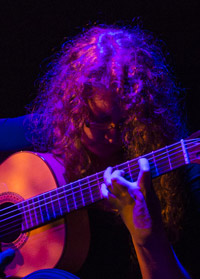 Composer and guitarist Amy Brandon’s pieces have been described as ‘… mesmerizing’ (Musicworks Magazine), and “otherworldly and meditative … a clashing of bleakness with beauty …” (Minor Seventh).
Composer and guitarist Amy Brandon’s pieces have been described as ‘… mesmerizing’ (Musicworks Magazine), and “otherworldly and meditative … a clashing of bleakness with beauty …” (Minor Seventh).
Upcoming 2020-21 events include a cello concerto for Jeff Zeigler and Symphony Nova Scotia, works for KIRKOS Ensemble (Ireland), Exponential Ensemble (NYC) and guitarist Libby Myers, as well as installations and performances at the Gaudeamus Festival, Winnipeg New Music Festival, Women from Space and Sound Symposium. She has received Canadian and international composition awards and honourable mentions from the Leo Brouwer Guitar Composition Competition (Grand Prize 2019), Central European String Quartet (‘Most Innovative’ 2018), and ArtsNS (Emerging Artist Award 2019).
In addition to performance and composition, she writes and presents academic work concerning music cognition, virtual reality, improvisation and the guitar. Holding degrees in jazz guitar performance and composition, Amy is currently completing an interdisciplinary PhD in music cognition at Dalhousie University in Halifax, Nova Scotia.
Audri Phillips – Spiral Strength

Link: https://vimeo.com/465686214
This is a VR piece(no interaction) done to music by Steve Roach. There is also a non VR version. I construct my work using layers of animation. I have found that the animations can be shot with different VR cameras from different points of view, yet they can still work together. One reason my visuals go well with the music of Steve Roach is that he also layers his sound. His music is very spatial and takes the audience on a journey. I tried to match that with the visuals. I wanted Spiral of Strength not to direct a viewer, but to operate as all good poetry does, allowing the viewer’s mind to open up. Spiral of Strength was shown in Fivars 2020 as well as featured on Steve Roach’s youtube channel.
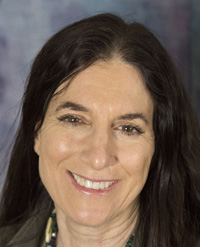 Biography:
Biography:
Audri Phillips, VJ/ 3D animator, content creator, immersive media specialist, based out of Los Angeles with a wide range of experience that includes over 25 years working in the visual effects/entertainment industry. Her full dome pieces, mixed reality, animations and paintings have been shown in festivals and conferences around the world.
She is the the co- founder and director of Robot Prayers an immersive trans media project which explores AI and our hybrid identities in a world where man and machine are melding, a resident artist at Vortex Domes, member of the Intel Innovators Group, ADN (Autodesk Developers Network), and a consultant/researcher for a technology company, Stratus Systems.
Eleni-Ira Panourgia – Web-canvas

Link: https://www.eleniirapanourgia.com/art/webcanvas
Web-canvas is an interactive web artwork that centers on simultaneous audiovisual material transformation through participation. This work’s audiovisual aesthetic includes visual material in the form of a cut-up digitized monotype and sonic material as acoustic and electronic sound samples. Web-canvas encourages its audience to interact by replacing its parts and transforming both its visual and sonic components. The artist’s sonic interpretation of the visual work is shared with the user and can be played back, reset, erased and recreated according to their own aesthetic decisions. Web-canvas is then a work that shifts the aesthetic power over the outcome between artist and audience. The mode of interaction of this work allows the audience to compose the canvas visually or aurally, by manipulating its pieces, which in their turn will trigger changes in the sound of the work. The concurrent visual and sonic interaction of the audience with the canvas is considered as the work itself. The multi-dimensional mode of this practice supports the idea of how changing one element will affect the whole. How we are bonded with everything around us is symbolized by the way each piece of the canvas constantly depends on the state of a larger entity. Audience-participants are invited to make sense of their actions based on the simultaneous changes of sound-to-visual. Web-canvas application was developed in collaboration with software engineer Kosmas Tsakmakidis in HTML, CSS and Javascript.
Biography:
 Dr. Eleni-Ira Panourgia is an artist working at the intersection of visual and sound arts. Eleni-Ira is a Teaching and Research Fellow at Gustav Eiffel University (former University of Paris Est Marne-la-Vallée) and Associate Fellow of the Higher Education Academy. She has recently completed a PhD in Art at the University of Edinburgh titled ‘Co-composition processes: form, structure and time across sculpture and sound’. Eleni-Ira’s work focuses on intersections of sculpture, spatial dimensions and sound in a responsive and interactive way in relation to materials, their processes and technologies. She explores the potential of such complex morphologies within artistic, design and social processes. Eleni-Ira’s work has been exhibited and presented internationally in museums, galleries, festivals and conferences in the UK, France, Switzerland, Italy, Greece, India. Eleni-Ira is member of the Littératures, Savoirs et Arts (LISAA) Research Lab, the International Media Music and Sound Arts Network in Education (IMMSANE), the Research Centre for Creative-Relational Inquiry (CCRI), RAFT Research Group, Onassis Scholars’ Association, Greek Sculptors’ Association and the Chamber of Fine Arts of Greece. She is co-founder and managing editor of Airea: Arts and Interdisciplinary Research Journal.
Dr. Eleni-Ira Panourgia is an artist working at the intersection of visual and sound arts. Eleni-Ira is a Teaching and Research Fellow at Gustav Eiffel University (former University of Paris Est Marne-la-Vallée) and Associate Fellow of the Higher Education Academy. She has recently completed a PhD in Art at the University of Edinburgh titled ‘Co-composition processes: form, structure and time across sculpture and sound’. Eleni-Ira’s work focuses on intersections of sculpture, spatial dimensions and sound in a responsive and interactive way in relation to materials, their processes and technologies. She explores the potential of such complex morphologies within artistic, design and social processes. Eleni-Ira’s work has been exhibited and presented internationally in museums, galleries, festivals and conferences in the UK, France, Switzerland, Italy, Greece, India. Eleni-Ira is member of the Littératures, Savoirs et Arts (LISAA) Research Lab, the International Media Music and Sound Arts Network in Education (IMMSANE), the Research Centre for Creative-Relational Inquiry (CCRI), RAFT Research Group, Onassis Scholars’ Association, Greek Sculptors’ Association and the Chamber of Fine Arts of Greece. She is co-founder and managing editor of Airea: Arts and Interdisciplinary Research Journal.
George Rahi – Edge Roaming
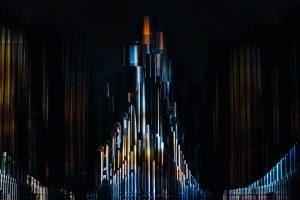
Edge Roaming is a series of compositions which merge the vibrant material and ethereal space of the pipe organ and the techniques of electronic and generative music. The project uses a custom digital interface to control acoustic pipe organs, allowing for real-time manipulation of all pipes and stops. With a reflexive attention to the organ’s harmonic design, the work incorporates site-specific elements such as the organ’s architecture and acoustics, using controlled feedback systems, algorithmic listening, and projection mapping to extend the resonant relationships between the instrument and its surrounding space. Through this process of hybridizing acoustic and digital imaginations, the project explores new sonic terrains that emerge through a digital approach to the world’s oldest mechanical synthesizer. In this presented excerpt of the larger concert-length work, the projection mapping provides a discrete visual choreography that reinforces the interval relations of the polyrhythmic form, transferring the MIDI data used to sound the organ into animations cast onto the instrument’s open structures.
This project was supported by the Centre for Interdisciplinary Research in Music, Media, and Technology (CIRMMT) and the Simon Fraser School for Contemporary Arts. Technical Support by Johnty Wang, Ben Cooper, and Samm Cooper.
Biography:
 George Rahi (b 1987) is a composer and sound artist based in Vancouver, unceded Coast Salish territories, Canada. He uses self-created and altered instruments as a method of exploring the intersections between acoustic and digital technologies, modes of listening, and spatial and architectural thinking. His work includes large-scale installations, compositions for pipe organ, solo & ensemble performance, and works for radio, theatre and public spaces. He has presented throughout North America, Europe, and Asia. He holds an MFA from Simon Fraser University and is the recipient of the 2018 R. Murray Schafer Soundscape award. Recent presentations have included Artificial Sonification (Matera), SPEKTRUM (Berlin), Kunst-Station Sankt Peter (Cologne), Fusebox Festival (Austin), Vancouver New Music, and Regenerative Feedback Festival (Rotterdam). In 2019 he was a guest composer in residence at EMS in Stockholm.
George Rahi (b 1987) is a composer and sound artist based in Vancouver, unceded Coast Salish territories, Canada. He uses self-created and altered instruments as a method of exploring the intersections between acoustic and digital technologies, modes of listening, and spatial and architectural thinking. His work includes large-scale installations, compositions for pipe organ, solo & ensemble performance, and works for radio, theatre and public spaces. He has presented throughout North America, Europe, and Asia. He holds an MFA from Simon Fraser University and is the recipient of the 2018 R. Murray Schafer Soundscape award. Recent presentations have included Artificial Sonification (Matera), SPEKTRUM (Berlin), Kunst-Station Sankt Peter (Cologne), Fusebox Festival (Austin), Vancouver New Music, and Regenerative Feedback Festival (Rotterdam). In 2019 he was a guest composer in residence at EMS in Stockholm.
Henry James – Robo Poems

https://www.henryjames.space/ts_idiot.html
(no longer available)
A semi-interactive web-piece comprised of a collection of ‘lockdown’ poems written by spoken word artist T.S.Idiot read by computer generated voices. The piece uses pseudo-random number generation to control new iterations of shapes and conduct the various synths that play ending in a crescendo of browser glitches and distorted audio.
 BIography:
BIography:
Visual artist/Programmer/DJ/Producer – Lover of all things vibrant, dusty and groovy, owner of Mint Tea records and a founding member of Do-IY.
Amy Cutler and Graham Dunning – Pilots

Link: https://amycutler.net/pilots
PILOTS: A daily collaboration by Amy Cutler and Graham Dunning. (B-roll jingles / idents; pilot episodes; petridish horizons) ‘there are no environments without veering’ – Veer Ecology: A Companion for Environmental Thinking // the pilot fish: a narrow, spiny-finned jackfish, said to precede the shark
Biographies:
Dr. Amy Cutler is an experimental geographer, filmmaker and sound artist who performs live audio-visual improvisation, tinkering with the histories of landscape, nature, science, and projection. Her performances and installations evolve from fieldwork, often using home-made torches and home-made projection booths, inspired by the do-it-yourself style of early film projections and their “phantasmagoria” (literally, assembly of spectres). Her sonic collaborations – most recently with Scott Pitkethly under the name RAVINE/MACHINE – perform ritual acts of projection while simultaneously offering an autopsy of those acts of projection, from Super8, to 35mm, to the use of liquids and specimens.
Graham Dunning is self-taught as an artist and musician having studied neither discipline academically. His live work explores sound as texture, timbre and something tactile, drawing on bedroom production, tinkering and recycling found objects. He also creates visual work, video and installations drawing on these themes. Much of the work evolves through experimentation with different processes: considering the methods by which sounds become music; process as a continuum encompassing both improvisational and procedural methods; and testing analogous processes across different media. Graham has performed solo and in ensembles across the UK, Europe and Canada, and exhibited in the UK, Europe, New Zealand and USA. He teaches Experimental Sound Art at the Mary Ward Centre in London and also gives various independent workshops. He has released through Entr’acte, Seagrave, Tombed Visions and more.
Ryan Ross Smith – Study no. 44 [Lecture1]

Link: http://ryanrosssmith.com/study44.html
Study no. 44 [Lecture1] is an exploration of how the lecture format itself can become an instance of its topic. In this case, the topic is Animated Notation, and the text is provided by an Animated Score. The score randomly (although it is fixed in the video version) determines what the speaker says, including score-derived electronics that both support and distract the speaker. Study no. 44 [Lecture1] can be presented for any amount of time.
Biography:
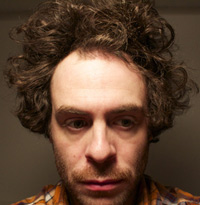 Ryan Ross Smith is a composer, performer, sound designer, engineer and educator currently based in New York. Smith has performed throughout the US, Europe and UK, has had his music performed throughout North America, Iceland, Denmark, Australia and the UK, has presented his work and research at conferences including NIME, ISEA, ICLI, ICLC, SMF, ACMC and TENOR, and has lectured at various colleges and universities. As a sound designer/engineer, Smith has produced work for ESPN (30 for 30 Podcast), ABC, Kassen Brothers Production, Voltage Control Records, and WNYC’s Studio360. In the academic world, Smith is known for his work with Animated Notation, and his Ph.D. research website is archived at animatednotation.com. Current & recent projects include Duets [a series of remotely-produced duets with musical friends from around the globe], Lines and Patterns [musique concrete disguised as ambient music], Green Dome [with Zeena Parkins and Ryan Sawyer], Ross Farwell [IDM/Breakbeat] and Sequential Switch [daily modular synthesizer project (2019)].
Ryan Ross Smith is a composer, performer, sound designer, engineer and educator currently based in New York. Smith has performed throughout the US, Europe and UK, has had his music performed throughout North America, Iceland, Denmark, Australia and the UK, has presented his work and research at conferences including NIME, ISEA, ICLI, ICLC, SMF, ACMC and TENOR, and has lectured at various colleges and universities. As a sound designer/engineer, Smith has produced work for ESPN (30 for 30 Podcast), ABC, Kassen Brothers Production, Voltage Control Records, and WNYC’s Studio360. In the academic world, Smith is known for his work with Animated Notation, and his Ph.D. research website is archived at animatednotation.com. Current & recent projects include Duets [a series of remotely-produced duets with musical friends from around the globe], Lines and Patterns [musique concrete disguised as ambient music], Green Dome [with Zeena Parkins and Ryan Sawyer], Ross Farwell [IDM/Breakbeat] and Sequential Switch [daily modular synthesizer project (2019)].
Teresa Connors – From the Edge (2019)

https://www.twitch.tv/tmconnors
Note that this was a live piece (and not archived), which streamed at specific times (GMT):
15:00 – 18:00 Saturday 12th Dec.
0:00 – 11:00 Sunday 13th Dec.
From the Edge is one of a series of audiovisual installations that explores the environment of East Coast Newfoundland. The work expands on my use of environmental data-sets as an artistic device to create nonlinear artworks for public engagement. The creative system is coded to live-stream data off the SmartAlantic St. John’s Buoy, which is located just north of Cape Spear, NL and 1 kilometre offshore. The buoy is capable of measuring and
transmitting a variety of atmospheric and surface conditions including: surface temperature; wind speed and direction; wave height, period and direction; as well as current speed and direction. From the Edge is coded to stream and parse these data-sets to trigger and shift parameters of this nonlinear work, which includes a visual particle system, audiovisual field recording material captured off this coast and improvised musical motifs. Developed in Max/MSP, the work continually evolves depending on the transmitted measurements.
Biography:
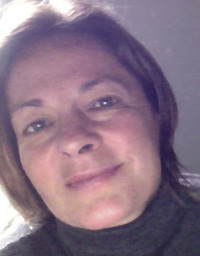 Teresa Connors is active as a creative coder, opera singer, and audiovisual installation artist. Her works have received awards and support, including ICMA Award, Canada Council for the Arts and British Columbia Arts Council, and have been presented at international conferences, film festivals and galleries and published in leading journals. Having recently completed postdoctoral research with the International Institute for Critical Studies in Improvisation, Teresa’s current artistic focus is the live streaming of environmental datasets as a co-creative device for public engagement artworks.
Teresa Connors is active as a creative coder, opera singer, and audiovisual installation artist. Her works have received awards and support, including ICMA Award, Canada Council for the Arts and British Columbia Arts Council, and have been presented at international conferences, film festivals and galleries and published in leading journals. Having recently completed postdoctoral research with the International Institute for Critical Studies in Improvisation, Teresa’s current artistic focus is the live streaming of environmental datasets as a co-creative device for public engagement artworks.
Scrapin’ the Barrel – Craig Earp / Klumpox / Limpid
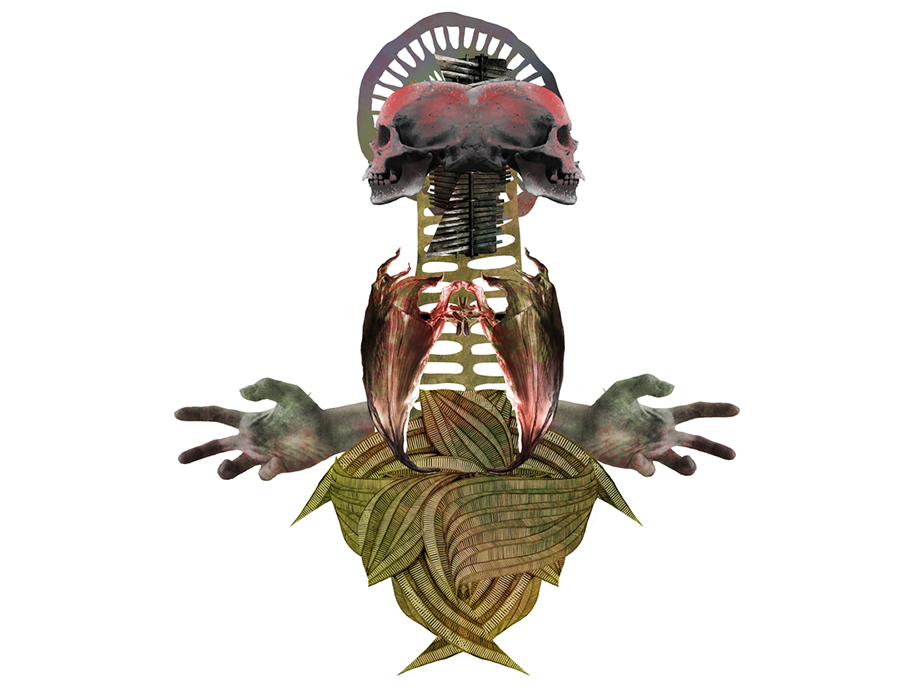
Link: https://www.craigearp.uk.com/limpid-scrapin-the-barrel
I was approached by the Artist, Anna Palmer (Dorcha/ Supersonic) during lockdown 1. Anna invited me to create an animated video for her solo music project as Limpid. The track is called ‘Scrapin’ the Barrel’. The video is a collaboration between Craig Earp and with Video artist, Klumpox from the Miasma collective. We had been discussing the possibility of a collaboration for sometime and this project seem to be the ideal time for this to happen.
The video was created throughout numerous zoom meetings. The brief from Anna was very simple; “I want the video to be dark”
Biographies:
Klumpox –
Visual artist, photographer, video mixer, design and construction of event environments, collaborator, animator, sculptor. Klumpox has been involved in a melting pot of creativity over the years drawing inspiration from surroundings and interests alike, collaborating with like minded individuals. Klumpox has worked on themed nights, festivals, art shows, public speaking events, bringing his own twist to enhance varied environments
Craig Earp –
Craig’s visual style is self taught and is inspired by organic forms, psychedelia and outsider art. His artwork encompasses a multi medium approach, from sculpture, photography to illustration and digital media. He enjoys creating work which fuses these mediums seamlessly. Craig has recently enjoyed painting as part the live art scene within Birmingham and is a founding member of both the Miasma collective and Distorted Minds Crew. He produces electronic music as part of the Birmingham based duo, HALT.
Over the past few years Craig’s work has featured in many international shows and publications. His creations have recently featured in ‘the Scary stories to tell in the Art’ exhibition in Texas USA, a show in Rome alongside the late great HR Giger, the Psychedelic Blasphemy art book by USA based Howl publications and for the French Macabre arts collective The United Dead Artists.
Minh Boutin – Singing Points

Link: http://singingpoints.glitch.me/
Singing Points is an interactive musical system inspired by minimal music composition’s processes. Each click generates a point emitting a wave whose note and frequency depends on its diameter. A note is played when a point is touched by a wave, making this autonomous system a random melody generator.
Margaret Anne Schedel, Brian Smith, Rob Cosgrove and Nick Hwang – Rhumb Line
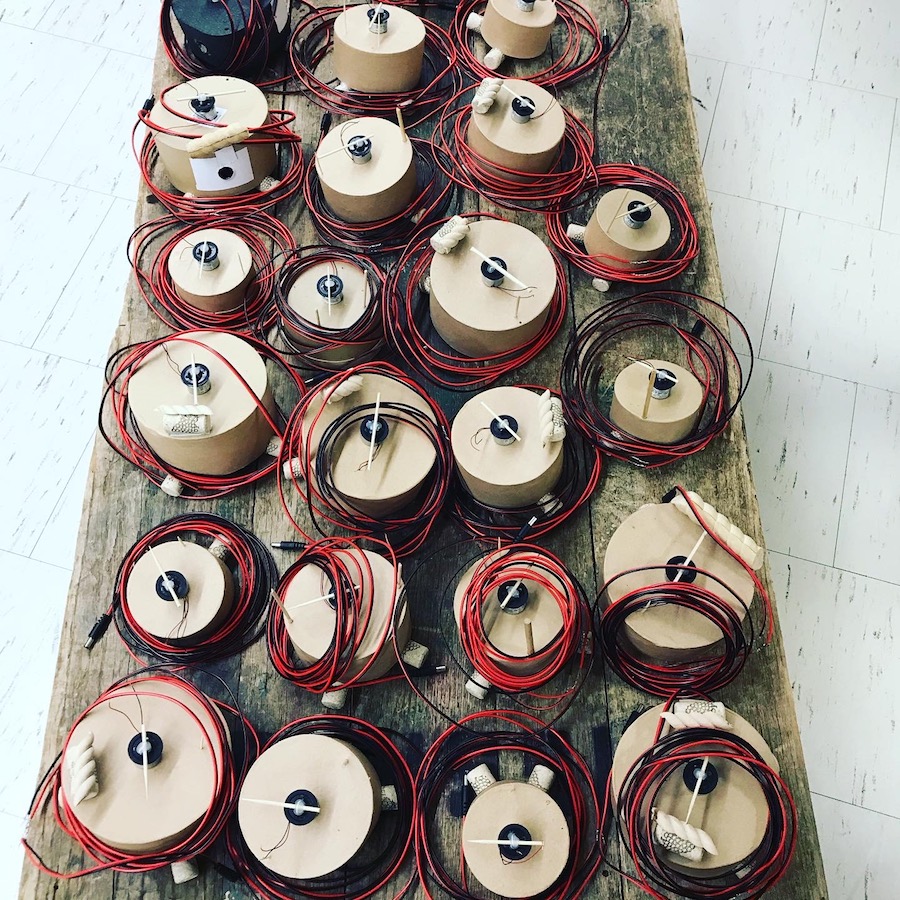
(this work is no longer available online, but a paper on it can be found here)
Global climate change has triggered a blaring silent alarm. This silence is a clarion call, a soundless scream from the environment itself for stewardship and protection. Against this silence, Rhumb-Line enacts a sonic reckoning, calling attention to forcibly silenced non-human victims of environmental destruction, and allows humans to sound on their behalf in acts of sonic retribution. Portending a dystopic future in which acoustic ecology is encountered only through the mechanical reproduction of environmental sounds, the sounds of this installation are created by a chorus of robotic frogs—a recognition of the catastrophic global population declines amphibians are facing. The virtual environment the robotic frogs inhabit, divided into two web pages, invites visitors to become temporary members of this fragile ecosystem. The first page creates an acousmatic listening experience—listening to a sound whose source is unseen—in which the frogs are heard but veiled from view. The second page allows visitors to peer behind the acousmatic “veil” that occludes the sound source from the visual field, see the robotic frogs, and control the listening experience of other visitors.
Biographies:
 With an interdisciplinary career blending classical training in cello and composition, sound/audio data research, and innovative computational arts education, Stony Brook professor Margaret Anne Schedel transcends the boundaries of disparate fields to produce integrated work at the nexus of computation and the arts. She has a diverse creative output with works spanning interactive multimedia operas, virtual reality experiences, sound art, video game scores, and compositions for a wide variety of classical instruments with interactive audio and video processing.
With an interdisciplinary career blending classical training in cello and composition, sound/audio data research, and innovative computational arts education, Stony Brook professor Margaret Anne Schedel transcends the boundaries of disparate fields to produce integrated work at the nexus of computation and the arts. She has a diverse creative output with works spanning interactive multimedia operas, virtual reality experiences, sound art, video game scores, and compositions for a wide variety of classical instruments with interactive audio and video processing.
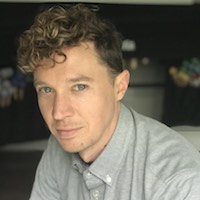 Brian Smith is a musician, writer, and artist interested in exploring cultural practices, social forces, and technology through the medium of sound. As a co-founder of the ensemble ScreenPlay, he pursues a deep interest in experimental musical practices and improvisation with audio-visual works that merge animated notational schemes and artistic sonification practices based on large-scale data sets. Brian’s current project, Human+, combines his interest in technologically-mediated sonic arts with a fiendish advocacy for new works by living composers to develop a repertoire of duets for musical robotics and percussionist.
Brian Smith is a musician, writer, and artist interested in exploring cultural practices, social forces, and technology through the medium of sound. As a co-founder of the ensemble ScreenPlay, he pursues a deep interest in experimental musical practices and improvisation with audio-visual works that merge animated notational schemes and artistic sonification practices based on large-scale data sets. Brian’s current project, Human+, combines his interest in technologically-mediated sonic arts with a fiendish advocacy for new works by living composers to develop a repertoire of duets for musical robotics and percussionist.
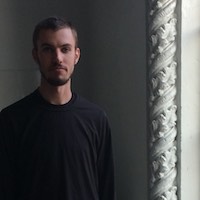 Rob Cosgrove is a percussionist, composer, and artist with a practice focused on experimental music and sound. Internationally exhibited and performed from Fridman Gallery to Carnegie Hall, his recent work focuses on novel uses of amplification, feedback systems, and complex textural strata. Rob is currently a doctoral candidate at SUNY Stony Brook in New York.
Rob Cosgrove is a percussionist, composer, and artist with a practice focused on experimental music and sound. Internationally exhibited and performed from Fridman Gallery to Carnegie Hall, his recent work focuses on novel uses of amplification, feedback systems, and complex textural strata. Rob is currently a doctoral candidate at SUNY Stony Brook in New York.
 Nick Hwang is a composer and sonic artist whose work explores connections in art, technology and interaction. He is currently an Assistant Professor at the University of Wisconsin at Whitewater. Nick earned his PhD in Compositional and Experimental Music & Digital Media at the Louisiana State University. Nick holds a Masters degree in Music Composition from Louisiana State University and B.A. in Theory and Composition from the University of Florida. His teachers have included James Paul Sain, Paul Koonce, Paul Richards, Paul Basler, Dinos Constantinides, and Stephen David Beck.
Nick Hwang is a composer and sonic artist whose work explores connections in art, technology and interaction. He is currently an Assistant Professor at the University of Wisconsin at Whitewater. Nick earned his PhD in Compositional and Experimental Music & Digital Media at the Louisiana State University. Nick holds a Masters degree in Music Composition from Louisiana State University and B.A. in Theory and Composition from the University of Florida. His teachers have included James Paul Sain, Paul Koonce, Paul Richards, Paul Basler, Dinos Constantinides, and Stephen David Beck.
Serge Bulat and Michael Rfdshir – Wuroom

Wurroom on itch.io (FREE): https://michaelrfdshir.itch.io/wurroom (No registration needed).
Wurroom on Steam (FREE): https://store.steampowered.com/app/1153130/Wurroom/
Wurroom is an experimental video game created by Michael Rfdshir and Serge Bulat. The project is a companion to Bulat’s new concept album Wurmenai. Wurroom is an immersive experience of a surreal utopia, taking the form of a short exploration adventure game.
Biography:
 Serge Bulat is a Moldovan-American multi-disciplinary artist, who has been involved in both European and American art scenes, exploring in various mediums: from music and visuals to radio and theater productions.
Serge Bulat is a Moldovan-American multi-disciplinary artist, who has been involved in both European and American art scenes, exploring in various mediums: from music and visuals to radio and theater productions.
The artist’s most notable works to date are “Queuelbum”, the concept project that won an IMA award for Best Electronic Album Of The Year; the audio/visual installations “Third World Walker” & “Inkblot” presented at music & art festivals in more than 10 countries, including NYCEMF (USA), Convergence (UK), Technarte (Spain), La Plata International Film Festival (Argentina), Video Art Forum, Saudi Arabia; and the experimental video game “Wurroom”.
The artist’s works were included in conferences and symposiums such as Convergence, UK (International Conference of Music, Technology & Ideas, organized by De Montfort and hosted by the MTI2 —Institute for Sonic Creativity); JAE: Electronic Art Days 2018, Argentina (organized by the Argentine Ministry of Science, Technology and Productive Innovation); Audio Mostly, UK (A Conference On Interaction With Sound, Nottingham University); New Music Gathering, USA; Milano Montagna Video Awards (Italy); and VU 3, USA (Symposium for Experimental, Electronic and Improvised Music).
Bulat’s artistic approach is often perceived as a meditation on arts, philosophy, science, and society; and explores such diverse subjects as creativity, technology, reality, culture, and identity.